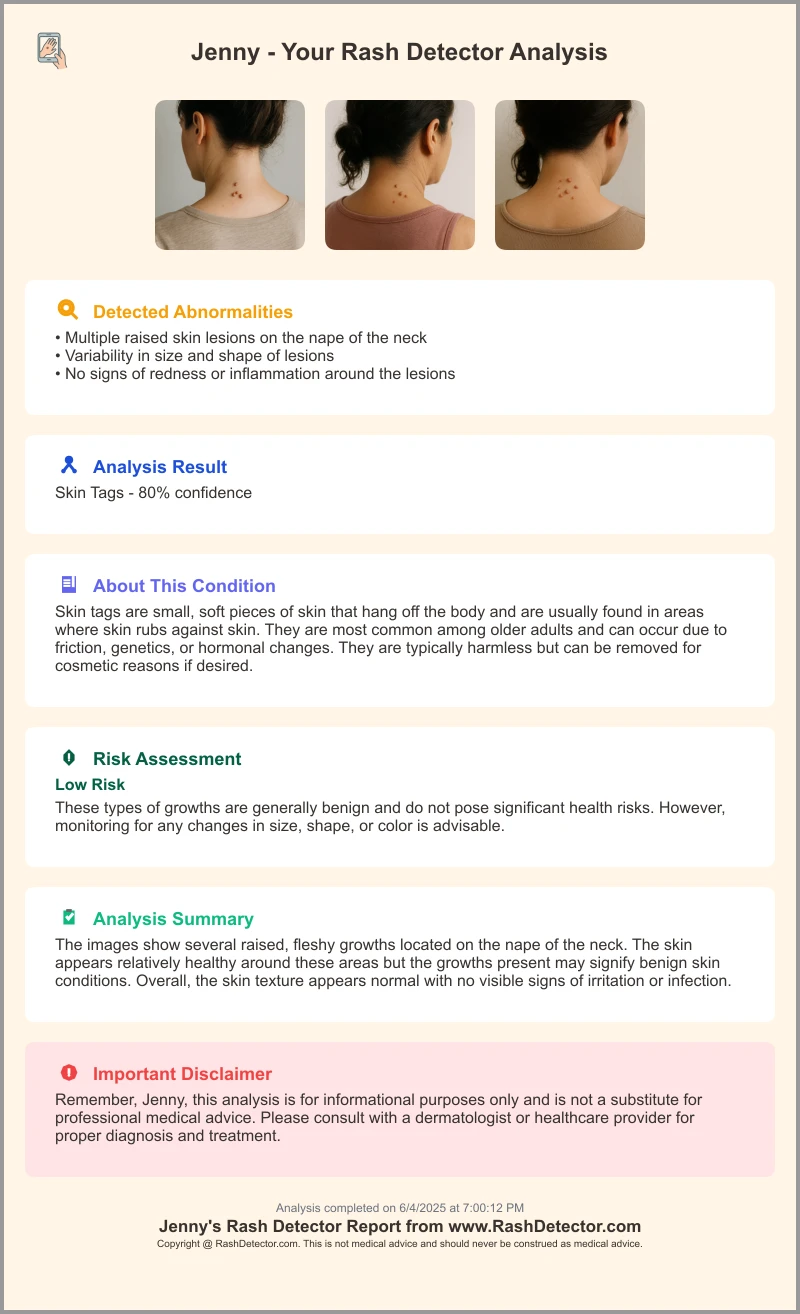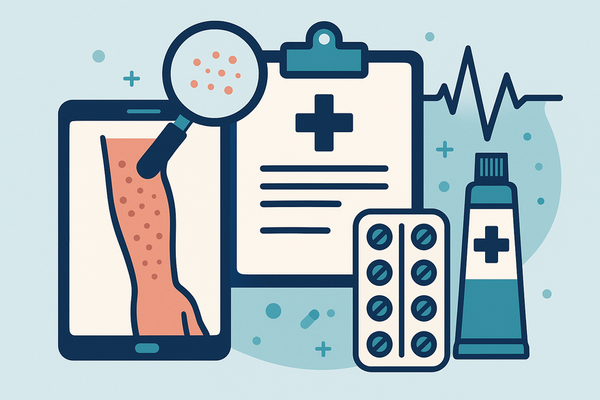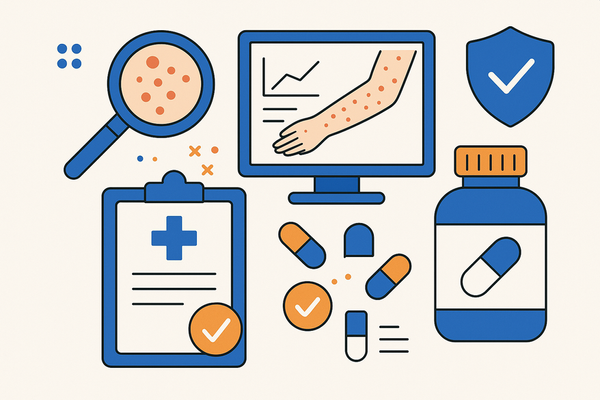Medication Rash Treatment: A Guide to Managing and Preventing Skin Reactions
Learn about medication rash treatment, identifying symptoms, and effective management strategies to prevent drug-induced skin reactions.

Estimated reading time: 9 minutes
Key Takeaways
- Range of severity: Medication rashes span from mild hives to life-threatening syndromes like SJS/TEN.
- Early recognition: Tracking onset timeline, symptom severity, and rash characteristics is vital.
- Evidence-based treatment: Includes supervised drug discontinuation, antihistamines, corticosteroids, and epinephrine when needed.
- Supportive care: Home remedies such as cool compresses and fragrance-free moisturisers complement medical therapy.
- Prevention: Detailed medication diaries, open communication with providers, and medical alert measures safeguard future care.
Table of Contents
- Introduction to Medication Rash Treatment
- Understanding Medication-Induced Rashes
- Identifying a Medication Rash
- Medication Rash Treatment Options
- Managing and Preventing Future Reactions
- Conclusion
Introduction to Medication Rash Treatment
Medication rash treatment is essential for anyone who develops a drug-related skin reaction. A medication rash occurs when the body reacts adversely to a drug, often manifesting as redness, hives, or bumps. Understanding key signs, treatment options, and prevention strategies helps you respond quickly and reduce risks.
For example, to support your self-assessment and track your rash over time, consider using Rash Detector, an AI-driven tool that analyzes uploaded rash photos and generates instant reports.

Understanding Medication-Induced Rashes
How Medications Trigger Skin Reactions
- Allergic immune response – The immune system misidentifies a drug or its byproducts, producing IgE antibodies that release histamine and cause itching, redness, or hives.
- Non-allergic immune response – Direct toxic effects of the drug or metabolites on skin cells cause inflammation without classic allergy markers.
*Real-world example:* A patient developed urticaria two hours after taking ibuprofen due to non-allergic histamine release.
Learn more at When is a drug rash more than just a rash? and in the AAFP Clinical Review on drug eruptions.
Common Types of Medication Rashes
- Hives (urticaria) – Raised, itchy welts that appear rapidly and shift location.
- Morbilliform rash – Pink or red maculopapular bumps 4–14 days after a new medication, spreading from torso to limbs.
- Severe reactions – Rare but critical:
- Stevens-Johnson syndrome (SJS) & toxic epidermal necrolysis (TEN): blistering, skin detachment, mucous membrane erosion.
- DRESS (Drug Reaction with Eosinophilia and Systemic Symptoms): widespread rash with fever, lymph node swelling, liver involvement.
*Case in point:* A teenager on lamotrigine developed an early morbilliform rash, prompting immediate drug cessation.
Further reading in the CCJM article on drug rashes.
Symptoms That Differentiate Medication Rashes
- Sudden onset after starting a new drug
- Fever accompanying rash
- Swelling or blistering of skin
- Mucous membrane involvement (mouth, eyes, genitals)
- Systemic symptoms such as joint pain or sore throat
Blistering and lip involvement warrant emergency care. See When is a drug rash more than just a rash? for details.
Identifying a Medication Rash
For comprehensive guidance on recognizing and assessing drug-induced rash symptoms, visit identifying drug-induced rash symptoms.
Recognising Rash Characteristics
- Onset timeline: Hives within hours; Morbilliform 4–14 days post-medication.
- Appearance: Red, itchy bumps that may coalesce into patches or blisters.
- Distribution: Often begins on the trunk and spreads outward.
These cues distinguish drug rashes from viral or contact dermatitis. More at Harvard Health Blog.
Reviewing Medical History & Medication Intake
- List all prescription and over-the-counter drugs
- Note dosages, routes, and start dates
- Include herbal supplements and vitamins
- Track dosage changes and new combinations
A clear log aids causality assessment. See Children's National drug rashes guide for pediatric examples.
When to Seek Professional Diagnosis
- Difficulty breathing or wheezing
- Facial or lip swelling (angioedema)
- Persistent or worsening rash, blistering
- Mucosal involvement in mouth, eyes, genitals
- Signs of anaphylaxis (vomiting, throat tightness)
Immediate medical attention ensures safe, effective care. Learn more at Children's National drug rashes guide.
Medication Rash Treatment Options
Discontinuing the Offending Drug
- Safely stop the suspected medication under healthcare supervision.
- Clinician arranges alternative therapies if the drug is essential.
- Monitor for improvement—rash typically fades within days.
Always consult your provider before halting any prescription. See NYU Langone hives treatment overview and Mayo Clinic drug allergy diagnosis & treatment.
Medical Treatments
- Antihistamines (e.g., cetirizine, hydroxyzine) to reduce itching and swelling.
- Topical corticosteroids (hydrocortisone 1%, triamcinolone) for local inflammation.
- Oral corticosteroids (short-course prednisone) for widespread rashes under tapering protocols.
- Epinephrine auto-injector in cases of anaphylaxis.
Choice depends on rash severity, patient age, and comorbidities. Details at NYU Langone and Mayo Clinic.
Home Remedies & Self-Care
- Cool compresses (10–15 minutes) to soothe itching.
- Fragrance-free moisturisers and gentle cleansers to preserve the skin barrier.
- Loose cotton clothing and quilting mitts to minimise scratching.
Supportive measures that complement medical therapy. Source: Harvard Health Blog.
Tailoring Treatment & Medical Supervision
- Clinician assesses rash severity (mild, moderate, severe).
- Age, weight, and organ function inform dosing and drug choice.
- Follow-up labs monitor for steroid side effects or organ involvement.
- Taper steroids as instructed with scheduled check-ins.
Customized care ensures safety and optimal outcomes. Guidance from Mayo Clinic and Children's National.
Managing and Preventing Future Reactions
To preempt flare-ups by pinpointing your triggers, explore our detailed rashes trigger identification guide.
Symptom Diary & Monitoring
- Record medication name, dose, start date, and route.
- Note rash onset, location, appearance, and symptoms.
- Log treatments tried and response timelines.
A detailed diary helps clinicians confirm causality and tailor future therapy.
Engaging Healthcare Providers
- Review all medications—including OTC and supplements—at every visit.
- Discuss the necessity of each drug and de-prescribe when possible.
- For essential meds with prior rash risk, explore desensitisation protocols.
Collaborative review reduces repeat drug eruptions. See Mayo Clinic drug allergy guide.
Preventive Measures
- Inform new providers of past drug reactions and update electronic health records.
- Wear a medical alert bracelet if you have a severe allergy history.
- Ask about cross-reactivity among drug classes (e.g., penicillins and cephalosporins).
- Consider slow graded dosing under medical supervision when unavoidable.
Proactive steps safeguard against future medication-induced skin reactions. Reference: Mayo Clinic.
Conclusion: Key Takeaways on Medication Rash Treatment
Medication rashes range from mild hives to life-threatening syndromes like SJS/TEN. Early recognition—tracking onset, symptoms, and drug history—is vital. Mainstay treatments include supervised discontinuation, antihistamines, corticosteroids, and emergency epinephrine. Home remedies ease symptoms, while tailored medical supervision ensures safe, effective outcomes. Prevent future reactions with careful record-keeping, open communication with providers, and alert identification measures. Always consult healthcare professionals before stopping drugs or starting new treatments to ensure safe, evidence-based medication rash treatment.
FAQ
- What are the first signs of a medication rash?
Look for sudden itching, redness, or hives shortly after starting a new drug. - When should I stop a medication if I suspect a rash?
Consult your healthcare provider immediately; do not stop essential medications without guidance. - Can home remedies replace medical treatment for drug rashes?
They can complement but not replace professional care, especially for severe reactions. - How can I avoid future drug-induced rashes?
Maintain a medication diary, inform providers of past reactions, and consider desensitisation if needed. - Are all rashes after drug use dangerous?
Most are mild, but watch for systemic signs like fever, blistering, or mucous membrane involvement.





